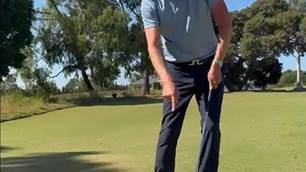This collection of drills from Adrian Fryer will rid this frustrating tendency from your game for good.
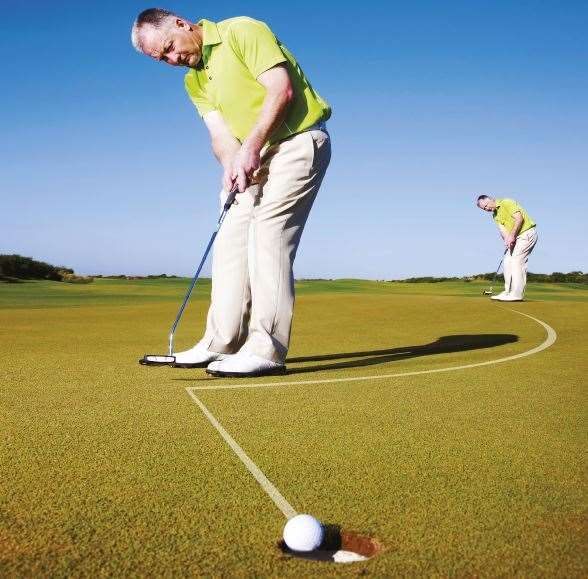 TEXT & IMAGEs: © BAUER CONSUMER MEDIA LIMITED
TEXT & IMAGEs: © BAUER CONSUMER MEDIA LIMITEDThis collection of drills from Adrian Fryer will rid this frustrating tendency from your game for good.
Words: Joel Tadman Photography:
It’s the most frustrating occurrence for golfers of every ability – three-putting. They happen either because you hit a poor approach putt from distance ... or struggle to hole out from close range. The first thing to understand is that one of these putts, the first one, is more feel-based – your instincts will largely take care of lag putts if you give them a chance. Whereas short putts are more mechanical and based on technique. But every putt is a combination of hitting the ball at the right pace on the intended line to your relevant target, which may not necessarily be the hole. You will reduce the number of times you three-putt every round by improving your touch from long range and your stroke on short putts. You can do this by practising the drills showcased in this feature by Adrian Fryer.
 TEXT & IMAGEs: © BAUER CONSUMER MEDIA LIMITED
TEXT & IMAGEs: © BAUER CONSUMER MEDIA LIMITEDLAG PUTTING: Let the putter swing
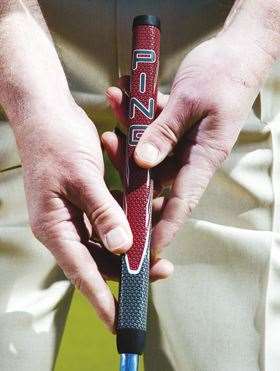 RIDE THE PUTTER: Feel that you hold the putter lightly and more in the fingers, letting it ride in the hands with the arm swing doing most of the work.
RIDE THE PUTTER: Feel that you hold the putter lightly and more in the fingers, letting it ride in the hands with the arm swing doing most of the work.When putting from long range, you’re permitted to introduce a small amount of wrist hinge to help the putter swing naturally.
The top of the handle shouldn’t move too much laterally either side away from its original starting point at address, almost like a fixed fulcrum where the putter swings back and through using the weight of the clubhead.
This method builds the momentum you need in the clubhead to send the ball the required distance, taking any ‘hit’ from excessive hand action out of the stroke. When players ‘hit’ at the ball with the hands they inevitably have to apply pressure to the shaft, which is difficult to control. Applying too much or not enough brings about that inconsistency and poor distance control that leaves too much work for the second putt.
On the practice putting green, hold the putter in your left hand against your sternum and let it swing back and through like a pendulum. This is the same motion the putter head should make in your stroke, with the butt of the handle moving very little. A slightly lighter grip will also help the shoulders control the stroke.
 TEXT & IMAGEs: © BAUER CONSUMER MEDIA LIMITED
TEXT & IMAGEs: © BAUER CONSUMER MEDIA LIMITEDLAG PUTTING: Assess the hole side
On long putts, getting the pace right should always take priority over the line. Get the speed correct and your ball shouldn’t finish too far away from tap-in range. But it doesn’t hurt to try to get both pace and line as accurate as possible ... and hole the putt.
Ultimately that is still your goal. By narrowing your focus in this way, instead of aiming for the ‘rubbish bin’ lid, your margin for error immediately increases. If you were to break the putt into three segments, the final third nearer the hole is where the slopes affect the ball’s journey the most, so make this your priority when assessing them, always from the low side.
1. If you won’t affect the pace of play, it’s always a good idea to look at your putt from behind the hole. The last few feet of your putt is where gravity will affect the roll of the ball most because it’s losing speed. So pay close attention to slopes on the green around the hole and take this into account when selecting your start line.
2. After you’ve read your putt from behind the hole, stand between your ball and the hole six feet from the hole’s location and make some practice strokes, visualising the path the ball will take in those last few feet. Remember not to ground the putter when doing this as you will be penalised two shots!
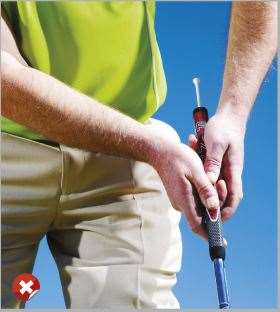 Shaft and belly united
Shaft and belly united
One way to illustrate the required pendulum motion of the putter and the relationship between the butt of the putter and the
belly button is to place a tee in the butt of the handle. The goal is for the tee to point at the belly button at every point during
the stroke.
Golfers often fail to let the putter swing by trying to keep the face square to the target for longer with the elbow and the handle moving forward with the clubhead. This makes the arms detach from the body, creating inconsistency of strike and distance control. It also causes the putter to rise up through impact excessively, increasing the chance of topping the ball.
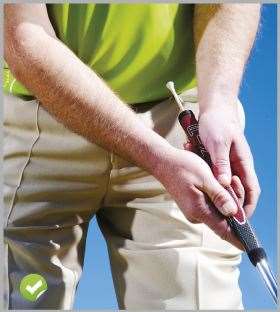 Tee points back to belly
Tee points back to belly
On long putts, the putterhead should pass the handle as it releases. If you think of the arc the putterhead makes during the stroke, moving from inside on the backswing, to square through impact then back inside during the finish, letting it swing so the tee points back at your belly button in the finish promotes a neutral path and square clubface. Even if your putter works more squarely, up and down the target line, the putter still needs to release with the clubhead ahead of the handle.
Notice the lack of angle in the back of the right wrist in the finish position compared to the incorrect opposite – this demonstrates a correct release crucial for lengthy putts.
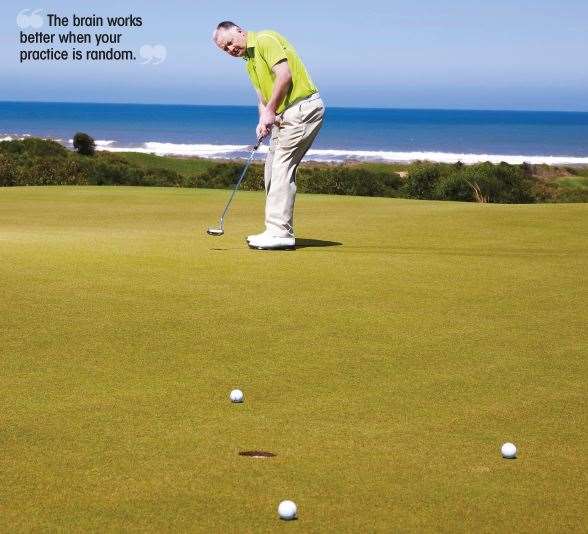 TEXT & IMAGEs: © BAUER CONSUMER MEDIA LIMITED
TEXT & IMAGEs: © BAUER CONSUMER MEDIA LIMITEDLAG PUTTING: Train your brain
We can all stand there and hit three or four balls to the same hole, learning from each effort and unsurprisingly, the last ball usually finishes the closest. But you take very little from this in the long run other than gaining the pace of the greens before you tee off; this routine has little point to it.
 FOOT MARKER: Use your right foot as a measure of how far to swing the putter back to make the ball go a certain distance – on your toe, before it or past it. The key here is to keep the tempo of your stroke the same.
FOOT MARKER: Use your right foot as a measure of how far to swing the putter back to make the ball go a certain distance – on your toe, before it or past it. The key here is to keep the tempo of your stroke the same.Research tells us that the brain predicts and works things out better when the practice is random. Practising to the same spot makes you lazy and doesn't prepare you for the course. Practising to different spots makes your brain work harder and more efficiently.
Set up to a hole 30 feet away and hit four balls to the four points of a compass around the hole – one short, one long, one left and one right. Changing the length and direction on each putt makes your prediction skills better for when you’re on the course. If you hit all your practice putts to the same spot, as soon as you (inevitably!) don’t get that length of putt on the course you aren’t prepared.

SHORT PUTTS: Split the difference
We can all have tendencies to aim left or right of our target – yet believe the putter is square. Then, when we make a good stroke, the ball misses. This occurs because we get lazy in our alignment. This drill makes your brain and eyes work a bit harder and is better at ensuring your putter is actually square.
1. Once you’ve picked the line you want the ball to start on (not necessarily the hole), take your address position, place the putterhead behind the ball and open it enough so it obviously aims right of the target.
2. Then close your putterface so it obviously aims excessively left of the target.
3. Finally, rotate the clubface so it is aligned in between these two directions. This gives you an assurance that your clubface is square and means you won’t second-guess yourself over the ball and make any last-moment compensations during the stroke.
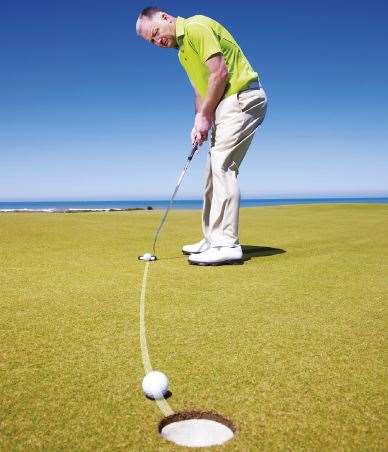 Snookered drill: Appreciating that breaking putts have a different entry point to straight putts gives you more chance of holing out.
Snookered drill: Appreciating that breaking putts have a different entry point to straight putts gives you more chance of holing out.Adopt a 'no fear' approach
Most amateurs get over-embroiled in technique on short putts and end up giving up and decelerating. But if you are conceded a putt or just leant over to tap one in, you’d instantly be more positive. You need to capture that same tempo when faced with short putts that carry a consequence. If you spend a long time thinking about it, that’s when you tend to decelerate.
Play snooker to understand the entry point
Short putts that have enough break on them to require you to aim outside the hole are tricky, because the pace has an influence on the amount the ball will break. My advice to you would be to hit the putts positively.
Remember that on breaking putts, the entry point changes, rotating around the hole left or right. Trying to die breaking putts into the front of the hole will often mean you’ll miss on the low side. As a drill, place a ball in front of the hole where the ball will funnel in from. Then, play a game of snooker, trying to knock that ball in. This drill allows you to appreciate how the angle the ball rolls in on changes and also helps ensure you strike your putts with enough pace and apply a positive stroke.
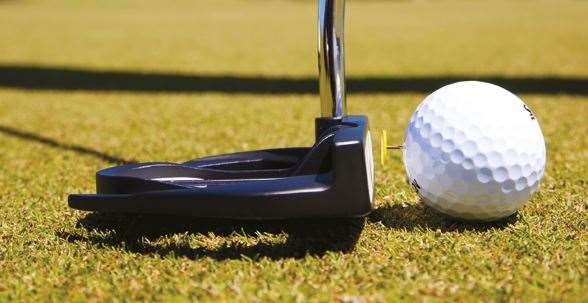
Short putts tap in the drawing pin
You need to focus on impact rather than what the stroke is doing. Your objective is to putt the ball in the hole, not to study whether the putter is going back square or too far inside, etc. Striking the back of the ball squarely is the key. As a mental tip, imagine there’s a drawing pin stuck in the ball on its equator; your job at impact is to push it further into the ball with your clubface. This requires a square clubface and a level blow, both of which will increase the likelihood of holing out.
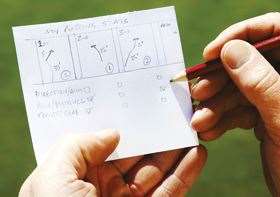 Chart your putting success: If you are honest, creating
Chart your putting success: If you are honest, creatinga diagram as shown above will provide an accurate
analysis and great feedback on where you need to focus your practice.
We have all been told how feedback and stats are keys to improvement but with putting they can be mis-leading, especially if you miss a lot of greens and chip close. One way of analysing your putting strengths and weaknesses is to chart your total putts on each green – not just the amount of putts but what they comprised. You are really studying your ability to read a green, your aim and ability to stroke your putt on target and at the right pace. The diagram (right) shows how I create a tick box of whether I aimed and got the target right, then stroke accuracy and pace.
Words: Joel Tadman Photography:
Related Articles
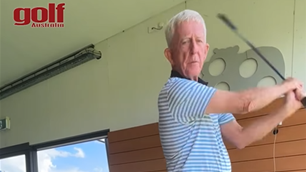
Video Lesson: Hear the swoosh past the ball

Playing From The Tips Ep.106: Texas Open, LIV Miami & LPGA Match Play
